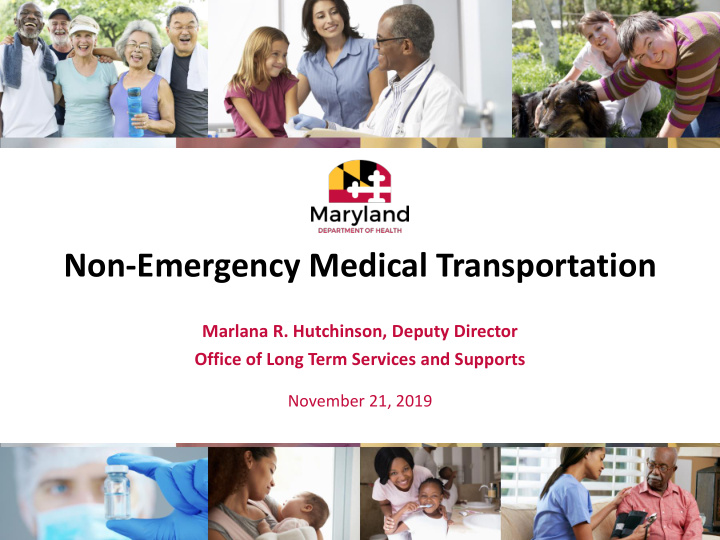



Non-Emergency Medical Transportation Marlana R. Hutchinson, Deputy Director Office of Long Term Services and Supports November 21, 2019
Agenda I. What is NEMT? II. Current Operating Model III. Phased NEMT Broker Implementation IV. Current Events V. Tentative Timeline & Future Activities 2
What is Non-Emergency Medical Transportation (NEMT)? 42 CFR – § 431.53 Assurance of transportation. A State Plan must specify that the Medicaid agency will ensure necessary transportation for recipients to and from providers and describe the methods that the agency will use to meet this requirement. Maryland Medicaid’s NEMT Program NEMT are transportation services for qualified Medicaid participants to ensure they are transported to covered medical services. 3
Current Operating Model • Under the authority of Maryland Medicaid’s State Plan, Maryland operates an in-house management model, as opposed to a Managed Care Organization model or third- party broker. • NEMT is provided through the Transportation Grants program (specified in COMAR 10.09.19) and is claimed as an administrative expense under an approved cost allocation plan. • MDH awards grants to 23 local health departments and the Montgomery County Department of Transportation via an interagency agreement. These entities are known as grantees. 4
Program Administration • Each local jurisdiction is responsible for the administration of funds to: • Screen requests to ensure eligibility and transportation necessity • Provide or arrange for the most efficient means of transportation, when no other transportation is available • Expand existing and develop new transportation resources, where necessary • Ensure Medicaid-funded transportation is provided consistent with the requirements outlined in CFR, COMAR, transmittals, the Condition of Award and Transportation Guide 5
Phased NEMT Broker Implementation
Phased NEMT Broker Implementation • Maryland Medicaid conducted a “diagnostic assessment” of its NEMT program. • Public Consulting Group Health (“PCG”), the conductor of the assessment, offered various options for consideration. • Maryland is pursuing a third-party statewide broker model to create an enhanced participant experience, provide quality service, streamline processes, improve program integrity, and achieve cost savings. 7
Impact of Statewide Broker • Maryland Medicaid expects to establish: • A more user-friendly and enhanced customer service experience • Standardized, efficient, and cost-effective processes • A statewide reimbursement rate • Increased independent access to care (e.g., the use of public transportation supplemented by the NEMT program) • An opportunity to receive an enhanced federal medical assistance percentage (FMAP), thereby reducing the amount of general funds needed to support the program 8
Approach • Phased implementation is under development. • The Department is actively working with MACHO and the local health officers to determine interest and readiness for the first phase. 9
Current Events
Current Events • The project charter established a Working Group and Steering Committee to oversee this effort. • The Working Group, comprised of local health department representatives and various other stakeholders, meets frequently to work on deliverables to meet certain milestones. Transition Planning – RFP Review Billing and Funding Transition – Human Resources Planning State Plan and Regulation – Vendor Contracts Amendments – Communication Plans 11
Tentative Timeline • Summer 2019-Spring/Summer 2020 – continue planning • Spring/Summer 2020 – publish RFP • Fall 2020/Winter 2021 – commence phased implementation 12
Marlana R. Hutchinson, Deputy Director Office of Long Term Services and Supports marlana.hutchinson@maryland.gov Office: 410-767-4003 Mobile: 443-938-1737 13
Recommend
More recommend